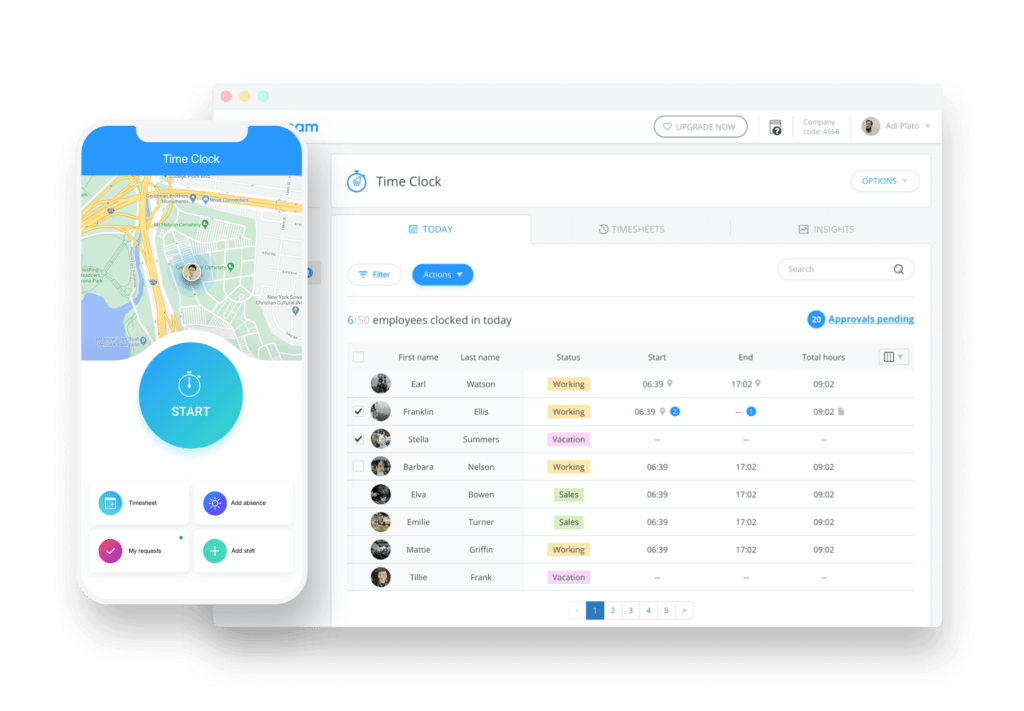True or false: Business owners are in the habit of making money. True, of course!
But, here’s the catch, far too many business owners are wasting money unnecessarily.
In fact, 82% of all businesses fail because of cash flow problems, reports Business Insider.
Reducing business costs and creating healthy processes that cost less over time doesn’t have to be time-consuming or take too much thought. It’s all just about making smart choices when reducing business costs.
We share 14 easy ways that you can reduce business costs. Trust us, it isn’t as complicated as you think.
1. Use The Right Technology
Using technology whenever possible can help you save money and take your business forward.
- Hold meetings virtually so you can save on petrol/gas money
- Use free online payment services, like PayPal or Venmo
- Google Docs or Trello are solutions that help organize and centralize your company documents, plus it’s a good tool to assist with project management
But if you’re looking for ways to effectively manage your business and your team without bleeding money then you need Connecteam. Connecteam is a leading all-in-one employee management app that offers robust features to help you streamline daily operations and increase employee engagement.
- Accuate payroll with GPS powered time tracking: right from their mobile phone, employees can clock in and out where a real-time timestamp and GPS location is tagged.
- Stronger internal communication: keep everyone up to date and engaged by sharing updates or newsletters via a social feed, start 1:1 or chat groups, and search for contacts with the in-app employee directory.
- Better employee engagement: issue surveys, share photos, videos, or GIFs, use the suggestion box, and create an open-door policy to increase employee engagement.
- Efficient training & onboarding: provide the best employee experience through direct access to training resources, including employee handbook, vacation policy, schedules, benefits, dress code, etc.
- Send and receive reports in real-time: streamline reporting while on the go with real-time reports that can be submitted from anywhere, like an expense reimbursement.
- Efficient job scheduling: build a schedule that is based on different requirements, provide all necessary information such as time, address, and special instructions, allow your team to accept and reject shifts, and more.
- Ensure compliance: keep your team compliant with digital ‘read-and-sign’ forms such as employee handbook, etc.
2. Rely On Modern Marketing Methods
Eliminating paid advertising isn’t advised altogether but there are some cheaper alternatives that you should explore when looking to reduce business costs:
- Network! Customers are more likely to work with you because they recognize you so take on all the networking opportunities.
- Do more of your marketing work in-house instead of paying someone else. Sure, there are plenty of experts out there but you can do some research online to find tips and guides that work for you.
- Boost your social media presence but choose the right platform for you such as Facebook, Snapchat, LinkedIn, Instagram, Twitter, Pinterest, etc. Be sure to set a goal and create a strategy, as posting randomly will get you nowhere. Just ensure that you’re being genuine and really connect with your audience.
- Offer a referral program while building your customer email list. Recommendations from current customers can lead to sales more quickly.
- Ask current customers to write reviews, whether, on your website or social media channel, glowing customer reviews are golden! Or ask for recommendations on Reddit or Quora. Remember that people trust online reviews almost as much as if they were to receive a recommendation from a friend or family member.
These modern methods really do work, however, to ensure you’re cutting business costs then you just need to try as many as possible to see what works and doesn’t work for you.
3. Go Paperless
Sure, the price of paper, ink, mailing supplies, and postage is minimal but it can add up to extraordinary amounts if you’re not careful.
By going paperless (unless printing is absolutely necessary), you can reduce these recurring business costs. Switch to a digital invoice and bill payment system and you can file all paperwork on your computer because once you print everything, you have to deal with piles of paperwork that will only clutter up the office space! And that’s not eco-friendly nor is it good for business costs.
And don’t get us started on all the checklists, forms, and reports your employees need access to. Especially when they’re on the go, the last thing they want to do is lug around binders of forms. And the last thing you want to do is go through each form manually if you even get it on time.
Select an app to handle all workflows! Whether it’s onboarding forms, expense reimbursement forms, vacation requests, sick leave forms, safety reports, invoices, equipment checkout, and whatever else you can think of can be filled from anywhere. Plus, it will automatically land on your desk in real-time. Everything you and your employees need is available at your fingertips.

4. Ditch The Landline
The time of the landline is over. Long over.
If you’re still using one, you’re bleeding money as it is an unnecessary business cost. Instead, you should use your cell phone, VoIP, or even virtual phone lines to save money.
In fact, AT&T has said that by 2020, they will remove landline coverage, “We’re investing in a technology that consumers have said they don’t want anymore and wasting precious hundreds of millions of dollars that could be going to the new technologies that would do a better job of serving customers.”
5. Create A Budget To Succeed
Budgeting is kind of a no-brainer when it comes to reducing business costs. You just can’t make smart financial decisions if you don’t actually have a clear idea of how much money is coming in and out each month. A budget allows you to have a daily view of how you can reduce business expenses right then and there.
Budgeting and financial management must be a focus so that you can avoid common mistakes. The best option is to create a “working budget”.
The term “working budget” means that it is a work in progress. The owner looks at it every day, consults it, follows it, and makes adjustments. It’s the game plan for the business.
A working budget allows you to make adjustments as you go along so that way you can cut business costs in real-time and not after the fact. As far as how to reduce business costs, this tip is really a no-brainer.
6. Lower Your Financial Expenditures
Take a close look at your insurance policies and financial accounts to reduce business expenses:
- Compare insurance providers to save money on insurance and then ask your current provider to match that rate.
- If possible, consolidate insurance policies or bank accounts.
- Evaluate insurance policies to check if you are being over-insured or have duplicating coverage.
- Avoid unnecessary debt. Conduct a thorough cost-benefit analysis and future forecasting looking into business expansion.
Consider opportunity costs and the effects that occur with debt payments on cash flow. Excess debt can strongly affect the company rating, interest rates, and borrowing in the future.
In addition, if you’re a small business owner, then chances are that your business credit card is in your own name. And if that’s the case, you need to pay off the card, in full, every month. However, interest charges can add up quickly so get into the habit of paying them off each month instead of adding up the amount and paying it off at the end of the year. Most credit card interest rates are 15.96% so that means you could save thousands every year by not having a balance on your credit card.
7. Time Management Cannot Be Overlooked
Time is money – isn’t that how the saying goes? So be sure to work productively without wasting time otherwise you’re just wasting money. And that’s the total opposite of reducing business costs.
- Minimize distractions with apps like Focus Booster, Todoist, or Rescue Time. These solutions can help you to focus by tracking sites that suck up your time so that you can stay on point.
- Connecteam and Toggl are apps that can track employee working hours, the time spent on work activities/projects, and shows billable hours. Not only does this show you how and where projects stand so you make smart business decisions, but it also ensures you have accurate timesheets when it’s time for payroll (with Connecteam, you can export timesheets directly to Quickbooks Online and Gusto for 100% accurate payroll).
- Set expectations for how long an activity or task should take and offer an incentive if the expectation is met or takes even less time.
- Meetings should run on a predetermined block of time so everyone has to show up on time, should stick to the agenda, and needs to wrap up at the appointed time.
- Avoid unnecessary meetings by having everyone send a meeting agenda so they can highlight what needs to be discussed. If you can answer most of their points in an email, then there is no need for a meeting. Plus, this allows you to show to the meeting with answers to what was raised instead of having to schedule a follow-up meeting.

8. Consider Location
If you don’t require a physical location for your business then don’t buy or rent one. Look into working from home, shared workplaces, or each week or month, you can switch out which home you and your employees work out of.
However, if a physical location is what you require then make the most of it. Analyze how much physical space you have because chances are you don’t need that much storage space. Consolidate different functions of your business, like having a space that is good for dual purposes. A meeting room could be a break room, for example.
9. Buy Refurbished Equipment
Brand new, retail-price equipment can be a huge business cost and it’s one that can be easily avoided. So, when thinking about how to reduce business costs start by buying refurbished furniture and equipment. After all, it’s just as good as the brand new equipment. You don’t need a brand new desk or chair, something from a Goodwill store or garage sale can do the trick just as well.
Remember that refurbishing doesn’t mean just one thing, it can involve reupholstering, adding a new finish or a different seat, and even painting some old furniture. Think about all those Pinterest before and after projects you see, it takes a simple touch and lots of patience to transform used equipment into a modern masterpiece.
10. Cut Down On Production Costs
There are ways to cut on business costs like material costs and to optimize your resources. Try this:
- Sell leftover cardboard, paper, and metal instead of recycling. Look into ways you can use your waste to create another product.
- Get the most out of your real estate. Centralize or consolidate any space possible and look into leasing unused space.
- Adjust and optimize resources by tracking and measuring the company’s operational efficiency. Set performance parameters that reflect your goals and offer incentives when goals are met.
11. Hire A Freelancer When Possible
Really consider if you need a full-time web developer, graphic designer, content writer, etc. Maybe you just need a few jobs a month? Offer part-time positions and be sure to outsource work for specialized tasks. However, choosing the cheapest freelancer isn’t always the smartest option as you might not get quality work in return. A good freelancer may have a high up-front cost but it’s better to pay someone one time for high-quality work than to pay someone over and over to fix it.
Fiverr and Upwork are top sites where you can find good quality and priced freelancers to get the job done.
12. Travel Less
We hinted at this earlier, but taking unnecessary trips will only eat up your time and will cause travel expenses to add up. Avoid this to reduce business costs by using online applications that offer quality video service, like Skype or Zoom. You can video conference, hold webinars, screen-share, and more.
Now, we know that due to COVID-19, traveling less is much easier than it was before and there are many businesses that are shifting to remote work when possible. So if you’re going to be working from home, ensure that you’re working productively.
13. Save On Electricity
Be strict on office policies because the electricity bill can be a ridiculously high business cost. Unplug unused electronics, turn off lights when not in use, use sunlit rooms, and more, to save on money. It seems like an easy way to reduce business costs but it’s often overlooked.
In addition, it can help to call your local electric company to have them run an electricity audit so you can better understand how electricity is being used at the office or even your home.
A few other tips include: change the lightbulbs as there are many energy-saving options available, check for air leaks, replace the air filter, set the thermostat so you don’t change it often.
14. Buy From The Little Guy
And finally, when looking at how to reduce business costs…go buy from the little guy!
Shopping locally offers you more flexibility, because, unlike big service providers, a small, local business can optimize their service to fit your needs like a glove. Write a list of all the major companies you work with and look into local listings to see if there is another company that costs less.
There are also more benefits to the whole community when you buy locally. For example, more jobs are created, money is kept in the community, locally owned businesses will contribute much more to local charities, the community stays unique and offers one-of-a-kind services, offers more consumer choices, reduces environmental impacts, and much more.
Bottom Line On How To Reduce Business Costs
No matter what level your business is currently on, from the startup phase to a well-established one, cutting business costs is always in the back of a business owner’s mind.
Through the tips we outlined above on how to reduce business costs, you have a ton of ideas up your sleeve when looking to reduce business costs, and the last thing you want to do is cut staff. This should always be the last step. Try a combination or even all of the tips above to reduce business costs at any point that’s needed.

